Abstract
Forest resource planning processes in the western United States have been placing an increasing emphasis on wildlife and fish habitat goals. With this in mind, we developed a method that incorporates a Habitat Effectiveness Index (HEI) for Roosevelt elk (Cervus elaphus roosevelti) into the objective function of a mathematical forest planning model. In addition, a commodity production goal is proposed (maximum timber production), and the habitat and commodity production goals are allowed to act as goals in a multi-objective goal programming planning problem. A heuristic programming technique (tabu search) is used to develop feasible solutions to the resulting non-linear, integer programming problem. Using a hypothetical example, we illustrate results of five scenarios, where the emphasis of the achievement of one or both goals is altered. The main contribution of this approach is the ability to measure and evaluate the trade-offs among achieving a certain level of a complex wildlife goal and achieving commodity production goals. These trade-offs are measured using a flexible model, allowing planners to formulate non-linear spatial goals as objectives of a problem, rather than forcing them to rely on posterior evaluations of the suitability of management plans to goals such as elk HEI.
Similar content being viewed by others
References
A. Ager and M. Hitchcock, Microcomputer software for calculating the western Oregon elk habitat effectiveness index, General Technical Report PNW-GTR-303 (USDA Forest Service, Portland, OR, 1992).
P. Bettinger, K.N. Johnson and J. Sessions, Forest planning in an Oregon case study: defining the problem and attempting to meet goals with a spatial-analysis technique, Environ. Manag. 20 (1996) 565–577.
P. Bettinger, J. Sessions and K. Boston, Using tabu search to schedule timber harvests subject to spatial wildlife goals for big game, Ecol. Modelling 94 (1997) 111–123.
P. Bettinger, J. Sessions and K.N. Johnson, Ensuring the compatibility of aquatic habitat and commodity production goals in eastern Oregon with a tabu search procedure, For. Sci. 44 (1998) 96–112.
F. Glover, Tabu search — Part I, ORSA J. Comput. 1 (1989) 190–206.
F. Glover and M. Laguna, Tabu search, in: Modern Heuristic Techniques for Combinatorial Problems, ed. C.R. Reeves (Wiley, New York, 1993) pp. 70–150.
J. Kangas and T. Pukkala, Operationalization of biological diversity as a decision objective in tactical forest planning, Canad. J. For. Res. 26 (1996) 103–111.
L.J. Lyon, Road density models describing habitat effectiveness for elk, J. For. 81 (1983) 592–595.
A.T. Murray and R.L. Church, Heuristic solution approaches to operational forest planning problems, Oper. Res. Spektrum 17 (1995) 193–203.
J. Sessions and S. Crim, Incorporating habitat suitability indices into large scale linear programs, Paper presented at 1995 ORSA/TIMS (INFORMS) National Meeting, Los Angeles, CA (1995).
M.J. Wisdom, L.R. Bright, C.G. Carey, W.W. Hines, R.J. Pederson, D.A. Smith, J.W. Thomas and G.W. Witmer, A model to evaluate elk habitat in western Oregon (USDA Forest Service, Portland, OR, 1986).
G.W. Witmer and D.S. deCalesta, Effects of forest roads on habitat use by Roosevelt elk, Northwest Sci. 59 (1985) 122–125.
G.W. Witmer, M. Wisdom, E.P. Harshman, R.J. Anderson, C. Carey, M.P. Kuttel, I.D. Luman, J.A. Rochelle, R.W. Scharpf and D.A. Smithey, in: Management of Wildlife and Fish Habitats in Forests of Western Oregon and Washington, Part 1 — Chapter Narratives, ed. E.R. Brown (USDA Forest Service, Portland, OR, 1985) pp. 231–258.
Author information
Authors and Affiliations
Rights and permissions
About this article
Cite this article
Bettinger, P., Boston, K. & Sessions, J. Combinatorial optimization of elk habitat effectiveness and timber harvest volume. Environmental Modeling & Assessment 4, 143–153 (1999). https://doi.org/10.1023/A:1019051931272
Issue Date:
DOI: https://doi.org/10.1023/A:1019051931272




